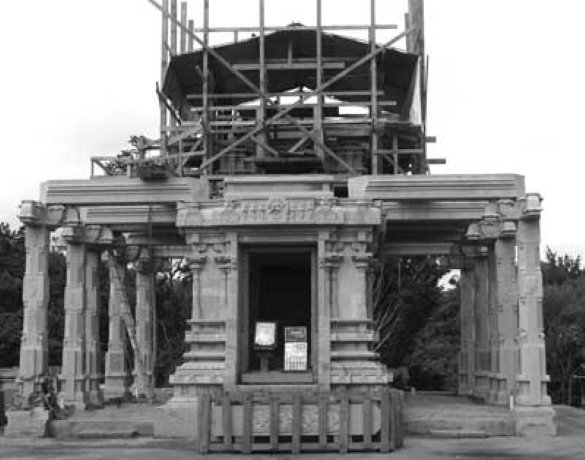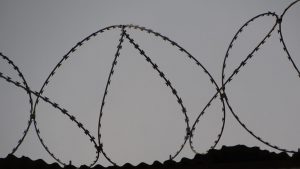Artisans from India have carved and cut stones by hand to build a temple deep in a Hawaiian jungle. Before his death, the monastery’s founder was strict in his instructions that no stone-cutting machinery be used, so that the stone’s “song” would not be silenced.
WAILUA, HAWAII
In a clearing within Kauai Aadheenam’s lush gardens, the ping, ping, pinging of metal chipping at stone can be heard over the sounds of bird calls.
A half-dozen artisans from South India put the finishing flourishes on the Hindu monastery’s legacy for the ages.
Hand-carved in granite and shipped in pieces to the island from India, the Iraivan Temple is faithful to the precise design formulas defined by South Indian temple builders a thousand years ago. The US$8-million temple to the god Shiva is the first all-stone Hindu temple outside of India, according to the Kauai monks. The project is a rarity even in India.
The ranks of skilled Indian carvers have dwindled in recent centuries, as stone has yielded to concrete and steel. Design modifications in new temples outside India have become a necessity to make worship at the traditionally open-air spaces bearable during the winters in Canada or New York City.
Lush, tropical Kauai, known as Hawaii’s Garden Isle, doesn’t have that problem.
“Actually it’s the first all-stone temple made anywhere in quite a while. I think our architect in India said he’s made two in 50 years,” said Sannyasin Arumugaswami, a generously bearded monk enveloped in an orange cotton robe.
Construction began in 1990 and could take another 10 years to finish because of the mass of the structure and the skill needed to build it. The temple has already incorporated 80 shipping containers worth of stone and is surmounted by a gold-gilt cupola carved over three years by just four men.
The temple is the vision of a former ballet dancer and Californian who founded the monastery back in 1970, Satguru Sivaya Subramuniyaswami.
Subramuniyaswami, who died at 74 in 2001, embraced Hindu monasticism in the late 1940s. Today his Kauai monastery is home to 22 monks who spend their days in prayer at the monastery’s current Kadavul Temple, tending the monastery’s fruit orchards and livestock, or putting out the order’s quarterly publication “Hinduism Today.”
The ascetics’ traditional orange, yellow or white cotton robes and shaved or bearded appearances belie their modern savvy. These monks have cell phones, digital cameras, podcasts and widescreen computer monitors to put out their magazine, with a worldwide circulation of 15,000 print and 5,000 digital. The monastery’s website gets up to 40,000 hits a day.
Subramuniyaswami left specific instructions for the new temple’s construction. No machinery may be used to cut the stone, which he believed would destroy the stone’s “song.” Machines are only used to lift some of the larger stones into place. The guru also required that the temple be built without debt, prompting a fundraising campaign that has so far raised $10 million toward its goal of $16 million, half of which would be set aside as a maintenance endowment.
The building still awaits part of its roof and its lava rock base that will be an homage to the design of sacred Hawaiian heiaus, ancient stone platforms used for worship in the islands. And the 700-pound crystal lingam, a symbol of the god Shiva, now housed in the monastery’s Kadavul Temple has yet to be installed in the new temple’s inner sanctum.
But the building began to spiritually “wake up” during a ceremony held last year.
“The way that we look at a temple in Hinduism is that the temple itself is a form of God. And so it is divine. It’s not just a building. That’s why we go through so much trouble to build it,” Arumugaswami said.
That attention shows in the narrative and decorative details throughout the structure. Twenty-four pillars feature bas-relief allegorical images of Hindu teachings. On one are two turtles, one with its legs extended and another retracted into its shell to symbolized the withdrawal of one’s senses during meditation. Another shows an archer, to illustrate karma and how destiny is made up of choices and actions.
Associated Press











Recent Comments
comments for this post are closed